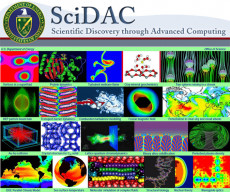Berkeley Lab Scientists to Lead, Support 12 New SciDAC Projects
December 7, 2017
When the Department of Energy announced the series of projects under the latest Scientific Discovery through Advanced Computing (SciDAC) program in late 2017, Berkeley Lab scientists, mathematicians and computer scientists were listed as key contributors in two institutes and 10 science application partnerships. Funding for the projects is expected to be more than $6.5 million annually over the next three to five years.
The SciDAC Institutes and Partnership Projects are key components of the program. While the institutes form the foundation for efforts by applied mathematicians and computer scientists to systematically address technical challenges inherent to the scale of new architectures and common across a wide range of science problems, the partnerships enable scientists to conduct complex scientific and engineering computations at a level of fidelity needed to simulate real-world conditions in targeted science projects. A critical aspect of the SciDAC program is the collaboration between domain scientists and mathematicians and computer scientists to ensure that the applications are both scientifically accurate and computationally efficient.
“The fact that so many of these new SciDAC projects are either led by or rely on the expertise of Berkeley Lab scientists, and that the latest round of funding spans all six DOE Office of Science program offices, is a strong endorsement of our leadership in computational science,” said Esmond Ng, who heads the Applied Mathematics Department in Berkeley Lab’s Computational Research Division (CRD) and is the SciDAC point of contact for CRD.
The SciDAC program, first launched in 2001, brings together teams of some of the nation’s top researchers at national laboratories and universities to create the software and infrastructure needed to help scientists effectively utilize the next generation of supercomputers for tacking the toughest scientific challenges – some of which can only be studied through high performance computation and simulation.
Here are the 2017 SciDAC Institutes with CRD staff participation:
- RAPIDS: Resource and Application Productivity through Computation, Information and Data Science. Director: Rob Ross, Argonne National Laboratory. Deputy Director: Lenny Oliker, Berkeley Lab
- FASTMath: Frameworks, Algorithms and Scalable Technologies for Mathematics. Director: Lori Diachin, Lawrence Livermore National Laboratory. Deputy Director: Esmond Ng.
CRD staff are also involved in 10 SciDAC Science Partnerships that have received funding:
- Probabilistic Sea-Level Projections from Ice Sheet and Earth Systems. CRD participants: Esmond Ng (co-PI), Dan Martin, Juliane Mueller, Brian Van Straalen. Program office: BER
- Advancing Catalysis Modeling: From Atomistic Chemistry to Whole System Simulation. CRD participants: Khaled Ibrahim, Sherry Li, Lin Lin, Esmond Ng, Sam Williams, Chao Yang. Program office: BES
- Partnership Center for High-fidelity Boundary Plasma Simulation. CRD participant: Mark Adams. Program office: FES
- CTTS: Center for Tokamak Transients Simulations. CRD participants: Sherry Li, Sam Williams. Program office: FES
- ISEP: Integrated Simulation of Energetic Particles in Burning Plasmas. CRD participants: Khaled Ibrahim, Sam Williams. Program office: FES
- Community Project for Accelerator Science and Simulation 4. CRD participants: Ann Almgren, Pieter Ghyseis, Mathias Jacquelin, Esmond Ng. Program office: HEP
- Accelerating HEP Science: Inference and Machine Learning at Extreme Scales. CRD Participants: Zarija Lukic, Dmitry Morozov, Juliane Mueller. Program office: HEP
- HPE Data Analytics on HPC. CRD participants: Paolo Calafiura, Zachary Marshall, Juliane Mueller. Program office: HEP
- Nuclear Computational Low Energy Initiative. CRD participants: Esmond Ng, Chao Yang. Program office: NP
- Towards Exascale Astrophysics of Mergers and Supernovae (TEAMS). CRD participants: Ann Almgren, John Bell. Program office: NP
About Berkeley Lab
Founded in 1931 on the belief that the biggest scientific challenges are best addressed by teams, Lawrence Berkeley National Laboratory and its scientists have been recognized with 16 Nobel Prizes. Today, Berkeley Lab researchers develop sustainable energy and environmental solutions, create useful new materials, advance the frontiers of computing, and probe the mysteries of life, matter, and the universe. Scientists from around the world rely on the Lab’s facilities for their own discovery science. Berkeley Lab is a multiprogram national laboratory, managed by the University of California for the U.S. Department of Energy’s Office of Science.
DOE’s Office of Science is the single largest supporter of basic research in the physical sciences in the United States, and is working to address some of the most pressing challenges of our time. For more information, please visit energy.gov/science.










